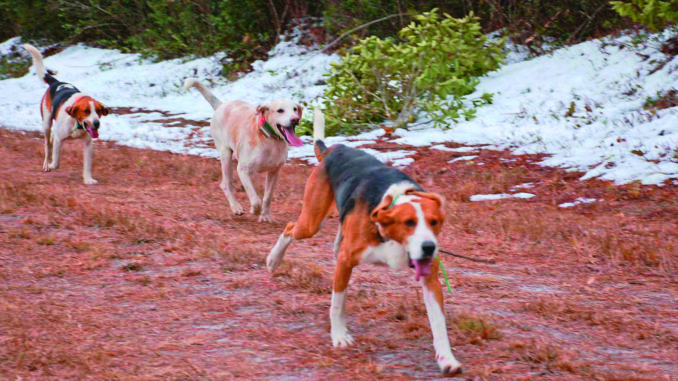
Hunters who run deer with hounds soak up the familiar melodies of their pack as they chase down a big buck, but deer are long-legged animals that often run long distances to evade the wrath of the dogs nipping at their heels.
Technology continues to improve, and tracking systems on deer hounds has a positive benefit for hunters and other property owners in the area as well.
Deer hounds are chosen for their keen sense of smell and unique tracking speed. Walkers are a very common breed of hound known for their speed and ability to stay right on the deer’s heels on a chase. While some deer will run in large circles, others, including mature deer, will run long distances well out of audible range in a matter of minutes. Tracking systems allow hunters to keep track of each of their dogs.
In the past, tracking systems used radio frequencies. Each dog had a collar and antenna that would emit a specific radio frequency. Hunters could pick up the dog’s location from two different locations on a receiver with an antenna and could triangulate the dog’s location. The range on the radio tracking systems was anywhere between three and five miles in most cases, depending on topography and land cover. In 2007, Garmin unveiled its sporting dog tracking system using Global Positioning System technology. The Garmin Astro package allows hunters to monitor up to 10 dogs at any given time and incorporates full-featured GPS capabilities. While the range is similar to the radio tracking systems, the GPS system allows hunters to know exactly where all of their dogs are at any given time.
Avid hunter Joey Nicoll has used both the radio and GPS-driven tracking systems and would not even attempt to go hunting without his GPS tracking system in place.
“The GPS system is unbelievable and is an advantage to us as dog hunters and for all other hunters on surrounding properties as well,” he said.
According to Nicoll, the benefits are endless. Historically, keeping the dogs on the right property has been a problem, to say the least, and many adjoining landowners have to deal with dogs entering their property on occasion disturbing their hunts.
“We make an extra effort to keep our dogs contained to our hunts. The GPS tracking system alerts us if our dogs are heading towards a property line, and we can cut them off to prevent them from leaving the hunt,” he said.
Hunters have huge monetary and time investments in their dogs, taking care of them year-round for three months of hunting. With food, veterinary care and other associated costs, the last thing a hunter wants to do is lose his dogs on somebody else’s property.
“No dog hunter wants their dogs on somebody else’s property,” he said.
The Garmin system provides track data that illustrates the dog’s travels throughout the day. Nicoll uses the track logs to determine the places deer travel after being jumped, and he’ll use that knowledge when trying to cut deer off.
“The GPS tracking system is a real benefit, allowing us to keep up with the chases, and it increases predictability of where the deer may go,” he said.
Editor’s note: This article is part of the Hound hunting feature in the October issue of North Carolina Sportsman. Digital editions can be downloaded right to your computer or smartphone.
Be sure to subscribe to ensure you don’t miss a single information-packed issue of North Carolina Sportsman.




Be the first to comment